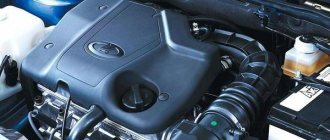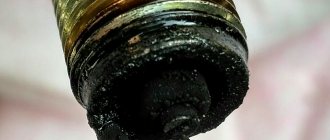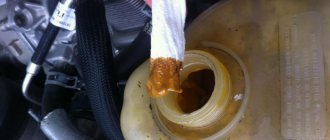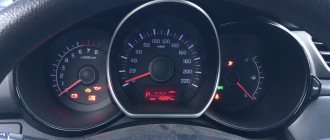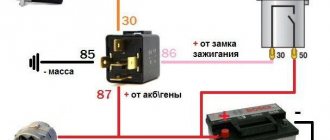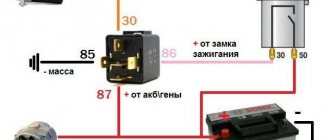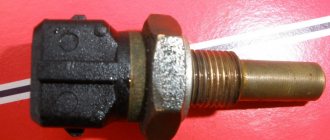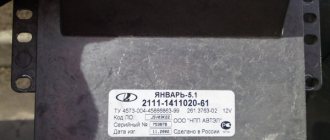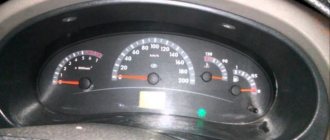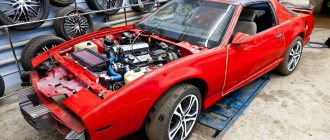Nowadays a car is not a luxury, but a means of transportation. Every driver has encountered a problem when his “iron horse” refuses to go. This is the most unpleasant situation, because of which you can be late for work, miss a vacation with friends or another important event. So what to do if the car won't start? To begin with, don’t panic, many problems can be solved on your own and without visiting a car service center. So, if the car does not start, you need to look for the reasons under the hood.
Voltage problems
A common problem when starting an engine is low voltage or no voltage at all. First of all, you need to check the fuses. Not every car depends on the safety system to start the engine, but it is still worth doing.
Over time, any wiring connections to the battery can become oxidized or dirty. This will result in no current flowing. It is necessary to clean the battery terminals and wire connections with a dry cloth or sandpaper. After that, try to start the car again.
If the terminals and wires are in order, then you should check the battery. A dead battery is a common problem. You can check the battery charge with a tester or by external signs. To check the performance of the battery, insert the key into the ignition and try to start the engine. A “weak” starter is a clear sign that the battery is discharged.
There are several ways to fix the problem with a dead battery. Light a cigarette from another car or try to start the car from a tow. The second method is only suitable for cars with a manual transmission. If the car does not start, you will have to remove the battery and charge it. Do not forget that the battery life is no more than 5 years.
Lada Kalina starts poorly and stalls when cold
Car: Lada Kalina, 2008. Asked by: Anonymous. The essence of the question: is it difficult to start when cold?
When cold it starts poorly, once started the revs increase sharply, then it stalls, the check engine light does not come on. When warmed up it works perfect. TPS and IAC replaced.
Mass air flow sensor as a problem area for poor engine starting
Most likely the mass air flow sensor is faulty. If the TPS and IAC are replaced, and you are confident in their performance, then there are no other options. It is best to look at the parameters of the mass air flow sensor when starting on a cold one, which it produces.
Your symptoms are similar to incorrect readings from this particular sensor.
Mass air flow sensor is one of the most expensive sensors in a car.
Problem with starter and ignition switch
The battery may be charged and the high voltage wires are fine, but you still won't be able to start the engine. Then the cause of the malfunction should be looked for at the ignition switch or starter.
To check the serviceability of the ignition switch, you need to insert the key into the ignition switch and turn it to the second position. If the red lights on the dashboard do not light up, then the ignition switch may be faulty. You can check it in another way. When you try to start the engine, turn on the headlights; if they start to dim, it means the ignition is in working order. A malfunction of the ignition switch can be eliminated in most cases by replacing the switch.
Corrosion and dirt damage not only the wires on the battery, but also the starter. To check the starter's performance, you will need a tester and an assistant. The electrical tester is connected to the wire that supplies the car's starter. At this moment, the assistant should try to start the engine. If the tester shows that there is electric current on the wire, but the starter does not crank, then this problem can be solved by replacing the starter. Attention! Do not forget about precautions, do not touch wires and other parts of the engine with bare hands. It is best to carry out this procedure while wearing dielectric gloves.
There are times when the starter turns, the car does not start. What to do in this situation? To answer the complex and trivial question of why the car won’t start, you need to check other components of the car. Lack of spark is another option why the engine refuses to start. Checking the spark plugs should be the last thing on your mind; first you need to deal with the ignition coil.
Ignition coils
If everything possible has been checked, but the car won’t start, and you don’t want to take it to the service station until you’ve tried everything that you can try to fix it yourself, check the ignition module (coil).
First, let's check the wiring. We disconnect the block of wires from the coil, connect the middle wire to the plus of the multimeter (in voltmeter mode), and connect the minus of the multimeter to ground.
If, when you turn on the ignition, a voltage approximately equal to the battery voltage appears, then everything is in order with the power supply; we check the control circuits.
To do this, connect a multimeter to the middle and one of the outer wires of the harness and turn the crankshaft with the starter - a voltage of a couple of volts should appear, similarly with the other outer wire. If the wiring is normal, check the coil.
Customized ignition coils
We switch the multimeter to ohmmeter mode, connect the tester to the middle and one of the outer terminals of the coil, if the circuit shows infinity, then that’s it - an open circuit. Same with the other extreme conclusion.
If everything is in order, we continue. We check the secondary winding - to do this, the coil must be removed from the engine and turned over. We connect the tester to the paired coil connectors - cylinders 1-4 or 2-3.
If it shows something other than infinity (should be something around 4 kOhm) then everything is fine, there is no break. Same thing with the other couple.
Ignition
So, if everything listed above is in good condition, check the ignition. First you need to test the ignition coil. It is checked with a multimeter. If such a device is not available, then you can stop by the nearest car service center.
It happens that moisture accumulates in the ignition distribution cover, this can cause the engine to not start. The cover must be removed and checked for moisture. Any moisture or condensation that appears must be removed with a dry cloth. Since you had to remove the cover, you should check it for cracks. A cracked lid should be replaced with a new one.
The wires on the ignition coil may be damaged or leaking electrical current. Place the tester near the wire insulation. Functional wires will not conduct current through the insulation. If the tester shows that the wires are faulty, you will have to buy new ones.
Checking the operation of the throttle valve
Very often, the cause of idle “floating” is a malfunction of the throttle position sensor (TPS). The graphite track inside a standardly installed part wears out over time, so it is replaced with a sensor with a non-contact system. After replacement, you need to reset the sensor error. To do this, disconnect the terminals from the battery for 30 seconds or more.
It is also necessary to check the cleanliness and integrity of the pipe leading from the air filter to the throttle valve, and adjust the tension of the gas pedal cable going to it.
It is also possible that the gasket of the throttle assembly has become unusable or the assembly itself needs to be thoroughly cleaned (motor oil could have gotten into it) with special compounds for washing carburetors.
Call Putin))) 495 879586741)))) he is with us………
Yes, I’ve been everywhere... I mean websites) who writes much, of course, the main reasons are indicated by the timing belt, sensor, coil (which were changed, to no avail). The diagnostician will arrive tomorrow
Spark plug
Spark plugs are designed to ignite fuel-air mixtures. They come in different types: spark, incandescent, semiconductor and others. If your car does not start, then turning the starter for a long time will lead to flooding of the spark plugs. After which they will need to be changed. Otherwise, working with flooded spark plugs will harm other parts of your car.
The problem lies in the candles
One of the reasons for the engine not starting is problems with spark plugs. When the Lada Kalina starts and stalls, this indicates that the spark plugs are flooded. This happens especially often in winter, frosty times, when a tired engine works at full power and cannot always cope with the load.
Dealing with flooded spark plugs is probably the simplest thing; even an inexperienced driver can handle it. You can dry the spark plugs by pressing the gas pedal all the way and holding it in this position for 15 seconds. If this method does not help, you will have to get out of the warm interior, open the hood and dry the spark plugs manually.
It's done like this. Take any brush, with which the candles are cleaned of carbon deposits, after which they are dried either with a hairdryer or in the oven; in the latter case, it is important not to overexpose them. In order not to bother with drying (this is especially annoying when you have to rush somewhere), it is better to always keep a set of spare spark plugs in the glove compartment. Install new ones and go about your business in peace. Just remember to dry the ones you took out in the evening.
If the Lada engine does not start well, what else could be the cause of the problem? Today it is very difficult to find high-quality fuel, especially when it comes to gas stations on the highway. It is advisable to fill up with fuel at gas stations that have been tested by time and other motorists. Don't expect the motor to eat everything. After several uses of low-quality fuel, it will certainly stall, after coughing and smoking.
Where there is gasoline, there is a fuel pump. This device malfunctions during the colder months of the year. This device is very complex, and it is better not to delve into it yourself; only an experienced technician will be able to fix the problem without bad consequences for the machine. But the driver can easily cope with a broken timing belt on his own. To do this, you simply need to replace the belt according to the instructions. We wish you patience and good mood when operating the car!
Problems in the fuel system
Car won't start? The starter cranks at full power, but the engine still won't start? Then the problem should be looked for in the fuel supply. Modern cars often use electronic fuel delivery. The problem is that it will be difficult to diagnose on your own. Diagnostic equipment is expensive, and you need to go to a car service center. But there are signs by which you can understand what kind of malfunction is in the fuel system, thereby saving you money on diagnostics.
The very first thing you should do is check all the electrical wires under the hood. It will take a lot of time, but it's better than paying a lot of money for diagnostics. Each injector that supplies fuel to the system has its own separate wire. Check all wires with a tester, and also pay attention to the insulation.
Car won't start? The causes of malfunction when starting the engine may be in the operation of the fuel pump. Its performance can only be checked using special equipment, which not every driver has. You can try to find out the cause by checking the voltage on the positive wire of the fuel pump. It may be missing due to a faulty fuse. If the fuse is good and there is no voltage in the wire, then this problem can be solved by replacing the fuel pump motor relay.
How and why the immobilizer fails
Let's dwell on this topic in a little more detail. The thing is that the ECU controller on this model is located under the heater radiator. In second-generation models, the controller was moved.
So, if the Kalina does not start, you need to remove the side wall from the left side in the passenger seat and visually check the ECU. The block must be dry. If it is wet, then it is filled with coolant - in this case, it will not be possible to restore the ECU, only replacement will help.
First of all, when exposed to liquid, the output switch burns out. The chip can be re-soldered, but after such repairs the problems will go away for literally two months, and then they will appear again. The heater radiator will need to be replaced. If this problem exists, then experts recommend installing a new controller between the engine compartment partition and the stove.
Now about the immobilizer - in Kalina cars the manufacturer installs APS-6 immobilizers. In very rare cases, these devices fail on their own. Often, the problem is hidden in the wiring or control panel. The key fob body is held together with one self-tapping screw - the screw can be overtightened or undertightened. A crack appears on the remote device chip between the transponder contacts. In this case, if the Kalina does not start, only a spare or training key, or replacing the remote control will help.
No compression
Does the car start and stall or not start at all? This may happen if the engine lacks compression. Compression in an engine is the ability to maintain the pressure that is created in the combustion chamber when the piston rises to its highest dead center. Compression is measured with a special device - a compression meter. Whether you need such a diagnosis can be determined by external signs. Blue smoke from the exhaust pipe, unstable engine operation or idle speed does not stand still - these are all reasons for weak compression. Such an engine will consume more oil and fuel. If you put your hand on the exhaust pipe and small drops of oil remain on your hand, then this is another symptom of engine failure. It is best to contact specialists. After all, the cause could be a burnt-out piston.
Lada does not start when cold: reasons
The following phenomena can cause a problem:
- Slow crankshaft rotation. This may occur due to a low battery or congealed engine oil.
- If the problem is in the entire fuel system. It happens that because the water in the ramp has dried up, the entire system malfunctions.
- Injectors leaking.
- The problem is in the motor system.
- Weak compression in the cylinders.
It is not always possible to identify and eliminate these causes on your own, so you have to contact a service center.
Timing problems
The timing belt is responsible for the operation of the engine in the car. Sometimes a metal chain is installed instead of a belt. Both are responsible for rotating the crankshaft and camshaft.
When using a car, every part wears out over time. The timing belt is no exception. Under constant load, it wears out and can rupture. Such a violation will lead to damage to the engine valves, and subsequently to its breakdown. And then a problem arises: the starter turns, the car does not start. What to do? A complete timing belt repair or valve belt replacement can be quite expensive. Therefore, to prevent such a problem from happening, it is advisable to change the belt every 2 years (this is approximately 60,000 km).
You shouldn’t delay replacing it if you don’t want to harm your beloved car. Leave the belt replacement to professionals to avoid stretching.
Main reasons
The engine does not start the first time
Kalina has a fairly common reason that it does not start the first time. This is due to design, wear and tear and electrical issues. But, it is worth breaking the problems into categories and considering them in more detail. So, let's look at the main categories into which this malfunction is divided:
When everything is sorted out into the causes, it is worth considering them in more detail and how to eliminate them on the car.
Fuel system
The first reason that a car may not start the first time is the fuel system. Insufficient fuel or too much gasoline becomes a problem. In this case, the starter turns, but starting is difficult. If the starter does not turn and the immobilizer icon is flashing, then the problem is already on the immobilizer side.
The engine does not start in cold weather
Starting a car in severe frost is difficult, but not hopeless. If the outside temperature is -15 °C or lower, then any battery loses 50% of its power, this is another problem why the car is a bad car, you need to turn on the high beam for 10-15 seconds. This will allow the electrolyte in the battery to warm up to produce additional energy.
Attention! Never turn the starter for more than 5 seconds. Otherwise, there is a chance that the battery will die completely or the spark plugs will flood, which is unacceptable at low temperatures. If the car is in good condition, then on the 2-3rd try everything will work out and your car will start.
It happens that the battery is completely dead. This can be understood if the car stalls and does not start. In this case, you will need a cigarette lighter. If the car has an injection engine, it will be more difficult to “light” due to the large number of electronics. You can “light” from another car even when its engine is running. The main thing is not to confuse polarity and order. However, if you made a mistake and mixed up the signs, run quickly to get a new battery.
After connecting to the “donor machine” you need to wait 10-15 minutes for your battery to charge. Afterwards, we disconnect from the car and try to start. If the engine starts, give it a couple of minutes, otherwise it will stall.
Remember that starting the engine at sub-zero temperatures is equal to 500 km. Take care of your car.
Candles
If the electronics are fine, there are still a lot of options why the engine won’t start. A common reason is that the candles are simply flooded.
Most often, candles are flooded in winter . Compression in the cold does not correspond to the parameters, so the engine does not start immediately. Often the spark plugs flood due to a weak battery that does not produce a normal spark, the wiring or the spark plugs themselves.
The easiest way to dry the spark plugs is to simply press the gas all the way to the floor and turn the engine with the starter for a few seconds (10-15). If there is nothing serious, then, as a rule, it will start (it rarely helps in winter), but if not, you will have to dry the spark plugs.
To do this, they need to be pulled out, cleaned of carbon deposits, for example with a toothbrush, the main thing is that the gap remains the same ( 0.8-1mm ), and then dried. You can use a hair dryer or even an oven if you are in a hurry.
Prudent drivers keep a spare set of spark plugs in the car for such cases. In order not to have to go to work in a minibus in the morning and not bother with drying, you can simply screw in spare candles, and in the evening, after work, calmly dry the main ones.
To reduce the risk that the spark plugs will be flooded, you need to constantly monitor the battery so that it is always charged and every two to three days, while driving, load the engine for 10 seconds to 4500-5000 rpm so that it cleans itself of carbon deposits and all sorts of deposits in the chamber.
Can't determine the cause?
Your car won't start, and you decide to find out the reason yourself, but it doesn't work. In this case, there is no need to “torture” your car. Contact specialized car services for help. The services contain highly specialized diagnostic equipment, with the help of which all faults and breakdowns of the car can be quickly found. After a complete diagnosis, they will tell you why your car won't start.
Turning the ignition key, the driver observes the same picture every time. First, the instrument panel indicators light up to indicate the presence of fuel and battery charge. In the extreme position, the starter turns on and begins to rotate the crankshaft. To start a serviceable engine, a few crankshaft revolutions are enough, but what to do when the starter works, but the car stubbornly refuses to start? The culprit for this situation can be a variety of malfunctions, because the normal operation of the engine is ensured by several automotive systems at once.
Immobilizer
The first reason why your Lada Kalina does not start, and which is easy to notice for yourself, is the immobilizer. If he blinked and beeped - sushi oars, sit down and read the manual. This problem is quite common and it is not easy to fix it, there is a lot of hassle, dancing with a tambourine and the like.
However, in the manual there is usually a decoding of the flashlight, which is illuminated by the light bulb - we count the seconds between flashes, the number of flashes, the number of buzzer signals - and look in the booklet what is written there about this.
In winter, it often happens that the car starts the fifth or sixth time . Most often this is solved by retraining the key, I won’t describe this problem, everything is in the manual, there shouldn’t be any problems.
Starting the internal combustion engine. How does this happen?
A car engine only works if several conditions are met:
- A sufficient amount of air-fuel mixture enters the cylinders.
- At a certain moment (at the end of the compression stroke), the spark plug generates a spark of the required power.
- The crankshaft and camshaft rotate with strict interaction, ensuring timely filling of the cylinders with the combustible mixture, proper functioning of the gas distribution system and operation of the fuel pump in carburetor internal combustion engines.
By turning the ignition key, the driver supplies power to the starter solenoid relay, which turns on its electric motor and ensures engagement with the crankshaft flywheel ring gear. As the crankshaft rotates, it converts angular momentum into reciprocating motion of the pistons and drives the camshaft (or shafts). The latter ensures timely opening of the valves, due to which the combustion chambers are filled with the fuel mixture at the right time.
The engine power system is responsible for its preparation and delivery. As soon as the piston reaches the top point at the end of the compression stroke, the fine fuel mixture is ignited by the spark formed on the spark plug (in diesel units, ignition occurs due to strong air compression). After this, the micro-explosion acts on the piston, which moves down and causes the crankshaft to rotate - this is what the engine starting diagram looks like.
The Lada Kalina car engine stalls when idling
One of the components that causes the Kalina engine to stop idling is the idle speed regulator (IAC), which becomes clogged with sticky dirt.
As a result, its needle remains in the closed position, and the combustible mixture stops flowing into the engine cylinders. In order to remove the IAC from its installation site and clean the needle using a special solvent or at least alcohol (liquid should not get inside), you must first warm up the engine, then disconnect the wires from it and immediately turn off the engine. In this case, the IAC needle (after removing it) will stick out above the plane of the connector and will be easier to clean. In this way, you can reanimate the IAC, but if this does not help, then it will have to be replaced. There are cases when voltage is simply not supplied to the IAC; in this case, you will have to check the contacts in the plug connectors and the integrity of the wires going to it.
The second problem with the engine idling may be the throttle sensor, which fails due to fairly rapid wear of the resistive layer of the variable resistor, since this layer does not like moisture and dust.
Why does the starter turn normally, but the engine does not catch and does not start?
In half the cases when a car refuses to start, the starter is to blame. At the same time, the other half occurs in situations where the starter regularly rotates the crankshaft, but the engine starts only after repeated attempts or is completely silent. This could be due to a variety of reasons.
Driver inattention or negligence
The notorious human factor can manifest itself in the most unexpected ways. For example, a banal lack of fuel or an alarm that blocks the fuel pump. It also happens that some “well-wisher” clogged the exhaust pipe, or a careless driver, while backing up, got stuck in a pile of soil or a snowdrift. Such reasons do not fall into the category of technical malfunctions, but they can spoil a lot of nerves.
Technical problems - starter malfunctions
Every more or less experienced driver will distinguish the sound of a starter, which regularly rotates the engine, from the useless buzz of its electric motor when there is no engagement with the flywheel. When starting to troubleshoot, you should definitely make sure that the starter is functioning normally, and that no extraneous knocks, clicks or malfunctions are observed during its operation.
Reasons why Kalina does not start
There are many cases when the LADA Kalina immobilizer does not give any warning signals, but the engine still refuses to start, and the reasons for this are unclear. Why won't it start in this case? Here the reason may be “hidden” in the starter. What happens is that the starter turns, but the car does not start. Determining the “culprit” is quite simple compared to a broken immobilizer. A discharged battery can cause the starter to lose functionality. This is not difficult to understand - just look at the dashboard after turning on the ignition. Not a single lamp or dashboard will “greet” the driver with its glow. Let's assume that the symbols do light up. Here you will need to turn on the headlights, activating the high beams, and then take a closer look at the intensity of the beam. If the luminous flux appears dim, this indicates the need to recharge the battery.
Timing belt Lada Kalina 8 valves
Electric power steering Lada Kalina
Armrest Kalina
Another situation may also develop in which the headlights emit a fairly intense beam of light for the first few seconds, and then begin to go out. This is a bad sign, which means you will need to “work” with the electrical network. What are the causes of the malfunction? Perhaps we are dealing with a failed starter and closing wiring. The cable lines of the node are diagnosed using a voltmeter. When switching the test device, we strictly follow the connection algorithm. We connect the red wire with the starter contact, and the black wire with the “ground” (unpainted part of the body) of the LADA Kalina car. The norm is characterized by a value of 12.5-14.5 V. If the device indicator is lower than the indicated value, then the wiring has significant problems. To eliminate them, you will need to resort to cleaning the contacts, inspecting the fuses and the electrical lines themselves for burns or breaks.
To force the starter to activate, you will need to connect a cable with a positive charge to its positive contact. This is called "short directly". The negative contact of the device must currently be switched to ground. At this time, the car must be secured using the hand brake, and the gearbox should be set to neutral. You can supply voltage, for example, from a battery. After power is supplied, the starter begins to come to life and rotates the engine flywheel, allowing the latter to start. There is little joy here, since after this one-time procedure you will need to contact the service for a more complete diagnosis and eradication of problems. However, it happens that the starter turns, but the engine does not respond.
Let us remind you that another reason that causes the engine not to start is a failure in the ECU, even if the starter turns. This device is made like a computer processor and is responsible for all the functionality of the electronic components in the car. This control module is located close to the interior heater. If leaks occur in the radiator of the heating system, then antifreeze is highly likely to penetrate inside the ECU housing. This constructive solution is not entirely correct.
Also, the “wetness” of the unit is due to the installation of an alarm system on the LADA Kalina. It lies in the fact that during installation the craftsmen forget to put the plugs, thereby creating the preconditions for moisture to penetrate inside the module. You can guarantee the safety of the device by moving it to a safer niche, for example, under the glove compartment. By the way, the plant has already resorted to this measure since 2013.
Problems with the fuel system
Even the most “vigorous” battery and a new, working starter will not be able to start the car if problems arise with the supply of fuel to the cylinders. For this reason, the next thing to check is the engine power supply system.
1.Fuel pump
For carburetor and diesel engines, this unit is located directly next to the cylinder head or block. Injection power plants are equipped with an electric pump, which is installed in the fuel tank. Their operation is judged by a short buzzing sound that appears after the ignition is turned on. As for fuel pumps in carburetor engines, they are mechanically driven by a cam mounted on the camshaft.
It is easy to check the functionality of the fuel pump - to do this, remove the hose from the carburetor inlet fitting and lower it into a suitable container. After this, you should pump up the fuel using the manual pumping lever or by turning on the starter. If the result is negative, check the passage of gasoline through the fuel line and clean the mesh located in the top cover of the pump. If this does not help, then inspect the membrane and valves of the fuel pump. After replacing damaged and worn parts, the functionality of the device will be restored.
2.Fuel filters
Along the path of fuel passing from the tank to the engine there are several filter units - coarse meshes located on the fuel receiver, in the fuel pump and carburetor, and in addition, paper filters located in the section of the fuel line. The intensity and even the possibility of supplying fuel to the internal combustion engine depends on their purity. If you find a blockage, clean or replace the filter elements.
Throttle and injectors
Gasoline internal combustion engines operate on a fuel mixture, which is prepared in the carburetor or in the intake manifold (for fuel-injected cars). In the first case, the fuel passes through a whole system of channels, jets and nozzles that are located in the carburetor. In the second, it is supplied by injectors according to signals received from the electronic engine control unit (ECU).
The air supply is metered using a throttle valve, which, depending on the engine design, can be mechanically or electrically driven. Clean the parts of this assembly and the throttle itself. Also check if fuel is being supplied to the cylinders. If you are dealing with an injection car, then press the fitting spool located at the bottom of the fuel rail - gasoline should flow out from there under pressure. If the stream is too weak, then check the filters, fuel line and pressure reducing valve of the fuel pump.
In carburetor engines, the fuel supply can be judged by sharply opening the throttle - in this case, a portion of fuel will be injected from the accelerator pump nozzle into the diffuser. In addition, for gasoline power units, inspect the spark plugs - they should not be dry. Otherwise, check for the presence of a control signal at the injectors. If everything is in order with this, then you should unscrew the ramp fastening and move it away from the manifold in order to inspect the spray nozzles when starting the engine. The absence of fuel streams or their weak intensity indicates the need to clean or replace the injectors.
As for diesel engines, fuel is supplied to them under high pressure, and a much more complex pump (fuel injection pump) and specially designed injectors are responsible for this. To repair these components, special equipment is required, so in this case it is better to contact specialists.
Something else useful for you:
Video: The starter hums, but the engine does not turn over
Malfunctions of electronic systems
To check the ignition system, unscrew and remove the spark plug from one engine cylinder. Having installed the tip of the high-voltage wire on its contact nut, touch the spark plug skirt to the cylinder head and crank the engine with the starter. In this case, a powerful spark of a purple or blue hue should appear on the contacts. If the spark is too weak (or there is none at all), then we check the operation of the computer, ignition coils and distributor (for an old-style internal combustion engine).
With modern computers installed in cars, engine starting failure occurs to a much lesser extent than before. But it does happen, and when it does, if you know some basic tests and procedures, it will allow you to determine why your car won't start and often even be able to fix the problem yourself without relying on repair shops.
Electronic control unit
Flooded ECU
Another common cause of problems with the Lada Kalina is the Electronic Control Unit, also known as the ECU, or the brains. In itself, it is a fairly reliable thing and if you don’t touch it, there will be no problems with it, but very often it turns out that it ends up flooded.
Yes, yes, this is the main problem with its malfunction. This often happens when antifreeze spills from the stove, since the unit is located almost under the radiator.
Often, when installing, say, an alarm system, when pulling wires into the interior, they forget to insert or insert the plugs poorly, and then splashes of water can get on the unit, which is also not good. It's useless to fix your brain.
Most often they will have to be changed; the only thing that can be done is to protect yourself from such a turn of fate by moving the control unit to another place.
No, you can, of course, wrap the block with plastic film or fill it with sealant, but in this case the brains will fail even earlier due to condensation that will inevitably appear inside.
It’s better not to risk it and move the brains somewhere under the glove compartment, for example, to do this we remove the plastic casing that is at the feet of the front passenger, on the left, remove the control unit from there - a flat metal box, and look for some safe place for it, of course the wires They're not particularly long, but they're long enough to hide the unit under the glove compartment.
In the updated Lada Kalina and Kalina 2nd generation, the ECU was moved to a different location, so this problem disappeared on new cars. But another one has appeared, if the drainage hole next to the cabin filter becomes clogged, then water through it during heavy rain gets to the ECU and almost the same thing happens. I advise you to check your water flow around the cabin filter more often!
Car starting process
To narrow down the reasons why the engine does not start, consider the process of starting a car. You need to better understand what happens when you turn the ignition key.
What happens on a properly running car?:
- You sit behind the wheel and insert the ignition key into the ignition.
- Turn the key to the first position - turn on the ignition, the lights on the instrument panel light up, and an internal test occurs.
- Turn the key further and the electric starter starts working, which in turn spins up the engine. It's easy to hear by ear.
- The next moment you hear that the engine has started, you must release the key, which will return to its original position. The engine is running and you are ready to start driving.
A number of things can go wrong during the engine starting process and we need to help you identify where the problem is in order to determine what needs to be done to resolve the situation.
Diagnostics
Have you noticed the above “symptoms”? Make sure that it is a faulty sensor that is causing the problem. If you have a voltmeter among the tools, you can carry out the diagnostics yourself.
Checking the circuit
Before checking the circuit, prepare a multimeter in advance and set it up to work. Next, open the hood and disconnect power from the idle air control. Then you need to set the voltmeter operating mode on the multimeter. The black probe needs to be connected to the ground of the car, and the red one is connected one by one to all the terminals on the block.
Checking the idle speed sensor on Lada Kalina
Using the help of a second person, start the engine and watch the multimeter readings. The parameters must be within 12 volts. If the multimeter shows a value that is significantly lower than expected, the cause must be sought in the battery, and when the voltage is completely absent, the cause must be sought in the wiring or in the engine control unit. If during verification it turns out that the circuit is working properly, you can focus on the sensor.
Sensor check
When checking the sensor, the multimeter must be switched to resistance testing mode. Next, regardless of polarity, you need to connect the probes to terminals A and B, then to C and D. The resistance at the working sensor should be within 53 Ohms.
After this, you need to connect the probe to all terminals one by one. The multimeter should show “infinity” in all connection options
The starter does not turn or turns but very slowly
When you turn the ignition key to start the engine, you should hear a rapid series of clicks, bad if you hear the sound of the engine cranking slowly or even nothing at all. The most common cause for any of these cases is a weak or dead battery , or dirty or oxidized (white coating) battery terminals.
Before going any further in troubleshooting, you need to turn on the headlights and then try to start the car. If there is insufficient or dim lighting when you turn the key, then the battery is to blame. If the light is bright and does not change when you turn the key to start the engine, then the battery is good.
In this case, the following reasons are possible:
- The gear selector is not in park or neutral, or there is a problem with the neutral safety switch. Try moving the gear selector to neutral again.
- You did not press the clutch pedal all the way down on a standard car (if the gear is engaged) or there are problems with the clutch. And in the case of an automatic transmission, they did not press the brake.
- There is a problem with the starter .
- Problem with connecting wires.
Starter
The immobilizer has been checked and does not give any alarms, but the engine still does not want to start. Another reason for this behavior is the starter. It is easy to notice a problem with the starter - you will not hear the characteristic sound of the engine starting. The mechanism simply does not spin, which means the engine will not be able to start. Everything is clear here - you need to remove and check the starter.
If the Kalina does not start, the first reason may be the battery. It may simply be discharged. If the lights in the cabin and on the dashboard are not lit, the driver will be able to immediately notice this. However, it often happens that everything is in order, but the starter still does not work. For diagnostics, turn on the high beams and get out of the car. Dim headlights are due to the battery. It is discharged, but only to a critical level, when there is not enough power to turn the starter.
If the Kalina does not start, the starter does not turn, the best way out of this situation is to charge the battery. But if the headlights are bright in high beam mode and are not going to dim, then you will have to look for the reason elsewhere.
The starter turns, but the car does not start
You turn the key and hear the starter working, but the engine does not start. This means the battery and starter are working properly.
If you continue to crank the engine for an extended period of time, the battery will eventually run out and will need to be recharged.
There are several reasons for this type of non-start condition. The most common of which is the fuel tank not delivering fuel Assuming there is fuel in the tank, you will need to go through a series of tests to determine what is causing the problem.
The testing procedure requires the use of specialized equipment to determine the problem area. There are three main tests to determine the correct direction to identify the fault. You will need to check the spark plugs, fuel delivery and compression , in that order.
Spark plug:
The easiest way to check the spark is to unscrew the spark plug from the engine block, insert it into the tip of the ignition wire and touch the threaded part of the spark plug to a metal part of the car, while someone else cranks the engine with the starter, you look at the side electrode of the spark plug , if a spark is visible, then the spark plug is working.
This procedure must be carried out with extreme caution! Handle only the rubber part of the wire, but under no circumstances hold on to the metal parts of the spark plug, so as not to receive a powerful electric shock!
You can also determine if the spark plug is working properly using an inexpensive spark tester. This is a device that is available at most auto stores. You can use it by simply holding the candle electrode near it.
If there is no spark, or a very weak spark, you will need to do a series of tests that depend on the type of vehicle. In this case, you cannot do without a specialized service station to get the correct diagnostic procedure.
If there is a spark, then you should proceed to check the fuel supply.
Fuel does not enter the engine:
First of all, you need to listen to the operation of the fuel pump inside the gas tank. When you turn the ignition key to the first position, you should hear the pump running: it makes noise for a few seconds to build up fuel pressure, then the noise goes away. If you don't hear it, it may mean the fuel pump or circuit is not working.
Fuel pump failure is a common problem on modern cars..
Cars are very sensitive to a certain fuel pressure. If the pressure does not meet the required parameters, this causes noticeable problems in operation or the engine does not start at all. To check fuel pressure, you need special equipment. Since you are working with flammable liquids, this type of work can be quite dangerous, so unless you know what you are doing, you should skip this step and take it to an auto repair shop.
Engine compression:
If you know you have spark and fuel, the next step is to check the compression . To do this, you need to remove the spark plugs and, using a compression gauge, test the compression ratio on each cylinder. If the compression is very low, then this is a sure sign that the engine requires repair.
Gasoline pump
Sometimes it happens that the fuel pump is capricious. Again, often during the cold season. The starter works, but the engine does not start, you cannot hear the fuel pump pumping, and sometimes the exclamation mark flashes.
To check whether there is pressure in the system, you need to open the hood, on the left, on the injector ramp, unscrew the black cap. There will be a nipple there, like in tires, if you press it, it should spray.
If it splashes, then it’s not the fuel pump, but if not, then we’ve found the culprit. As a rule, after recharging the battery, the fuel pump starts working, but if not, we look for the reason.
Often the relay is to blame. In the transmission tunnel, on the passenger side, we unscrew the casing, in the same place where we unscrewed it when we transferred the brains. There will be several power coils, three usually, you just need to tap them or warm them in your hands.
You also need to check whether the ECU is flooded, but if it is moved, as mentioned above, then this is not the reason. The best option is of course a service station. This is always the best option, but it costs money, so it’s better to do everything described above, in case there’s some little thing that can be corrected on your own.
You can get to the fuel pump yourself, it’s located under the rear sofa, fold it back, unscrew 4 screws and there it is, first remove the connector, take a multi-meter or a light bulb with two wires (test), insert contacts on the black and gray wires, turn with the starter, The lamp should be on and the multi-meter should show approximately 12V.
Having made sure that the voltage reaches the fuel pump, but it does not work, we quickly remove it and inspect it, perhaps the coarse filter has iced up (in winter), but if not, then we change it.
If the lamp does not light up and the multi-meter refuses to show the treasured 12V, go to the front seats, open the plug where we have the ECU diagnostic connector and there are 3 fuses, check them, and at the same time look at the relay, as described just above.
Conclusions or what to do?
As you can see, of all the possible options, you can even get to the service yourself only in the first cases considered. If the starter turns, but the car does not start, then most likely (unless you are a car mechanic) you will have to call for help.
If your starter does not work or the battery is simply dead , and the car has a manual transmission, you can start it with a pusher. To do this, you will need the help of passers-by or another car.
Never try to push start a car with an automatic transmission! This will only break it.
How to start a car with a pushrod
You need to: turn on the ignition, depress the clutch and start towing or pushing the car (it is advisable to pick up at least a speed of 10 km/h). Engage second gear and release the clutch. The car will jerk and start. Depress the clutch again and put the gearbox in neutral. Thank your rescuers and DO NOT turn off the car!
If the reason is a dead battery due to forgotten electrical appliances being turned on, then driving for 15-20 minutes will be enough for the battery to charge again and be enough for the next engine start.
And if you were unable to start because of the starter, then we advise you to go to a service station and do not turn off the car, otherwise you will have to start it again with outside help.
Good luck on the roads and keep an eye on your friend's technical condition.
Features of the starter and immobilizer
Kalina is sensitive to poor fuel quality
Kalina was assembled using technology, some of which was borrowed from old developments, and some was taken from imported projects and slightly adjusted in our manner. Everything would be fine, but Kalina reacts poorly to the slightest tests of strength. Broken roads, low-quality gasoline or something else like that lead it to a state of collapse.
Because of this, Kalina is much inferior not only to its imported analogues, but even to the simple domestic UAZ, which, although it is a drab little car, is reliable and, with proper care, will last for decades. With Kalina there is no hope for this.
The causes of starting problems may lie in the engine. Perhaps you had to fill the car with gasoline that was not of the best quality, which contained impurities that played a fatal role in the performance of the car. Another option is that some parts are worn out and need to be replaced.
There are more complicated reasons, for example, failures in the electronic system of the power unit. In this case, it will be very difficult to cope with the breakdown on your own, and it is more advisable to turn to specialists. A defective fuel pump can also affect your car's starting, and the list of possible problems goes on and on.
It was in vain that the AvtoVAZ team decided to follow the western path, without having the proper experience. Of course, we wanted the best, but it turned out as always. Let Kalina be a logical continuation of the well-known “fives” and “sevens”, albeit not a bright one, but a more or less reliable car. But the masters embarked on experiments that have been going on for decades, but they cannot be called successful.
Immobilizer control unit
An immobilizer is a good thing, but only when its design meets all existing reliability requirements. But it fails quite often. The problem will be indicated by a flashing signal sent by the device. You can often hear a characteristic warning sound. Fixing a breakdown is not easy.
First, you need to diagnose the immobilizer by monitoring the light bulb signals and counting them by seconds. Then you will have to look at the operating instructions, where the decoding of this Morse code should be given. Based on what signals the light bulb gave us, we decide what to do next.
